Butter Beans Recipe: A Culinary Guide opens a window into the world of these creamy, versatile legumes, revealing their rich history, nutritional benefits, and culinary possibilities. From classic Southern dishes to global cuisine, butter beans have a place at the table, offering a delightful blend of flavor and texture.
This guide explores the diverse world of butter beans, starting with their origins and nutritional value. We delve into a variety of recipes, showcasing their versatility in different cuisines. Discover the best cooking methods for achieving the perfect texture and flavor, and explore unique flavor combinations that will elevate your culinary creations.
Introduction to Butter Beans
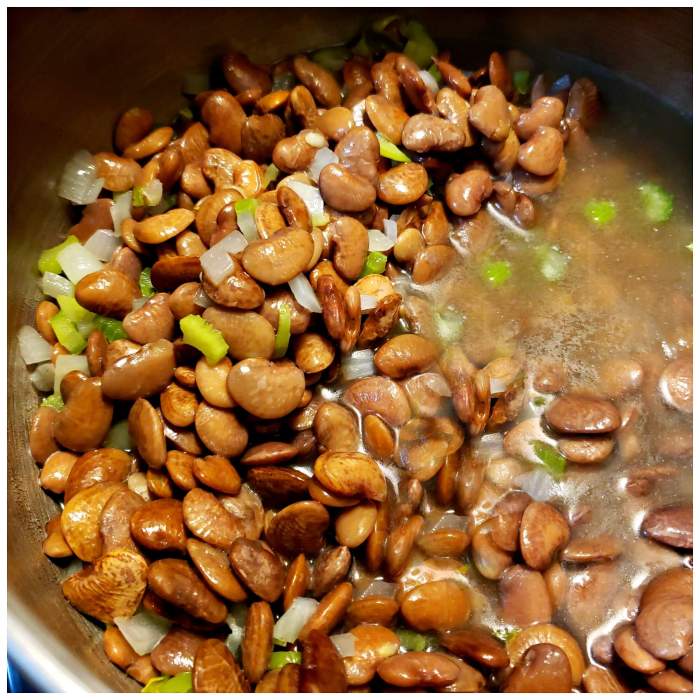
Butter beans, also known as lima beans, are a type of legume that has been enjoyed for centuries. Their origins can be traced back to the Andean region of South America, where they were cultivated by indigenous peoples. Over time, butter beans spread to other parts of the world, becoming a staple food in many cultures.Butter beans are a nutritious and versatile ingredient, offering a range of health benefits.
They are a good source of protein, fiber, and essential vitamins and minerals. These beans are also low in fat and calories, making them a healthy choice for weight management.
Nutritional Benefits of Butter Beans
Butter beans are a nutritional powerhouse, providing numerous health benefits. Here are some key nutritional aspects:
- Protein:Butter beans are a good source of protein, providing approximately 15 grams per cooked cup. Protein is essential for building and repairing tissues, producing enzymes and hormones, and maintaining a healthy immune system.
- Fiber:These beans are rich in fiber, with about 15 grams per cooked cup. Fiber aids in digestion, promotes regularity, and helps regulate blood sugar levels.
- Vitamins and Minerals:Butter beans are a good source of several essential vitamins and minerals, including folate, magnesium, potassium, and iron. These nutrients play vital roles in various bodily functions, such as energy production, nerve function, and red blood cell formation.
- Low in Fat and Calories:Butter beans are relatively low in fat and calories, making them a healthy choice for weight management. A cooked cup of butter beans contains approximately 220 calories and 1 gram of fat.
Interesting Facts About Butter Beans
Butter beans have a rich history and some interesting facts:
- Origin:Butter beans originated in the Andean region of South America, where they were cultivated by indigenous peoples for thousands of years.
- Variety:There are various types of butter beans, each with its unique characteristics. Some common varieties include baby limas, Fordhook limas, and sieva beans.
- Culinary Uses:Butter beans are a versatile ingredient used in various cuisines worldwide. They can be enjoyed in soups, stews, salads, dips, and side dishes.
- Storage:Butter beans can be stored in the refrigerator for up to 5 days or frozen for several months.
Butter Bean Recipes
Butter beans, also known as lima beans, are a versatile and flavorful legume that can be incorporated into a variety of dishes. They offer a creamy texture and a mild, nutty flavor that complements many cuisines. From classic salads to hearty stews, butter beans add a nutritious and satisfying element to any meal.
Butter Bean Recipes
Butter beans are a versatile ingredient that can be used in many different dishes. Here are five popular butter bean recipes, including variations:
| Recipe Name | Ingredients | Instructions | Serving Suggestions |
|---|---|---|---|
| Butter Bean Salad |
|
|
|
| Butter Bean Soup |
|
|
|
| Butter Bean Dip |
|
|
|
| Butter Bean Stew |
|
|
|
| Butter Bean and Spinach Curry |
|
|
|
Butter Bean Cooking Techniques
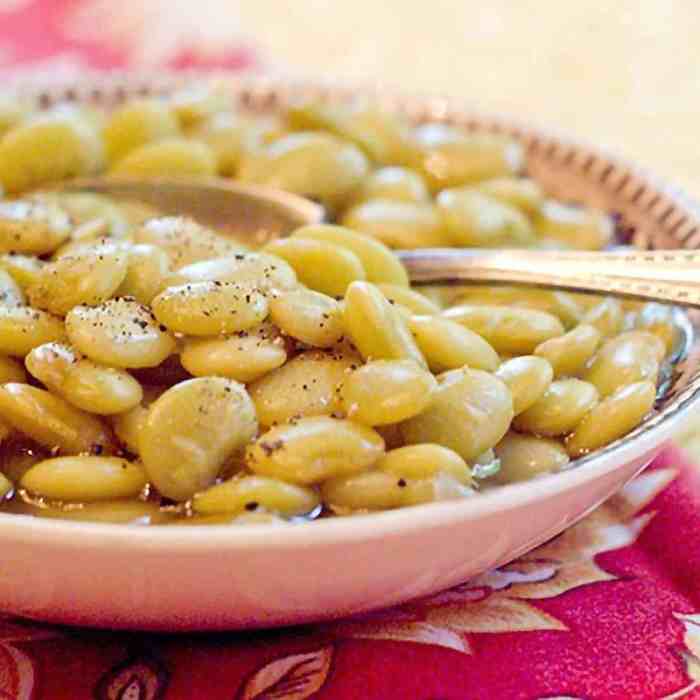
Butter beans, also known as lima beans, are a versatile legume that can be cooked in a variety of ways. The method you choose will depend on your desired texture and flavor, as well as your time constraints.
Boiling
Boiling is the most straightforward method for cooking butter beans. It involves simmering the beans in water until they are tender. Boiling butter beans is simple and requires minimal effort. You can add aromatics like onions, garlic, or herbs to the boiling water for added flavor.
However, boiling can sometimes lead to a mushy texture, especially if the beans are overcooked.
Pressure Cooking
Pressure cooking is a faster and more efficient method for cooking butter beans. It uses high pressure to cook the beans quickly and evenly. This method results in tender beans with a slightly firmer texture compared to boiling. Pressure cooking also helps to preserve the beans’ nutrients and flavor.
Baking
Baking butter beans is a less common but equally delicious method. It involves roasting the beans in the oven with olive oil, herbs, and spices. Baking brings out the natural sweetness of the beans and creates a slightly crispy exterior.
This method is ideal for adding a smoky or roasted flavor to the beans.
Butter Bean Flavor Combinations
Butter beans are a versatile ingredient that can be used in a wide range of dishes. Their mild, slightly sweet flavor lends itself well to various flavor pairings, from savory to sweet. Exploring different flavor combinations can elevate your butter bean dishes and create exciting culinary experiences.
Common Flavor Pairings
Butter beans pair well with a variety of herbs, spices, and vegetables, creating diverse flavor profiles.
- Herbs:Thyme, rosemary, sage, parsley, dill, and cilantro complement the earthy notes of butter beans. These herbs can be used fresh, dried, or in infused oils.
- Spices:Garlic, onion, cumin, paprika, chili powder, and turmeric add depth and complexity to butter bean dishes. Spices can be used whole, ground, or as a paste.
- Vegetables:Tomatoes, onions, peppers, carrots, celery, and spinach are common vegetables that enhance the flavor of butter beans. These vegetables can be roasted, sautéed, or simmered with the beans.
Regional Flavor Combinations
Different regions have unique flavor combinations that reflect their culinary traditions and local ingredients.
- Mediterranean:Butter beans are often paired with garlic, lemon, olive oil, oregano, and tomatoes in Mediterranean cuisine. These ingredients create a bright and flavorful dish.
- Southern US:Butter beans are a staple in Southern US cuisine, where they are often cooked with ham hocks, onions, and garlic. This combination creates a rich and savory dish.
- Latin America:Butter beans are used in various Latin American dishes, often with cilantro, cumin, and chili powder. These spices add a spicy and aromatic touch.
Unique Flavor Pairings
Butter beans can be used in unexpected and creative ways, resulting in unique and delicious dishes.
- Butter beans with roasted sweet potatoes and maple syrup:This combination creates a sweet and savory dish with a touch of smoky flavor.
- Butter beans with curry powder and coconut milk:This pairing creates a flavorful and creamy dish with a hint of spice.
- Butter bean salad with roasted red peppers and feta cheese:This salad is a refreshing and flavorful combination of sweet, savory, and tangy flavors.
Butter Bean Dishes Around the World
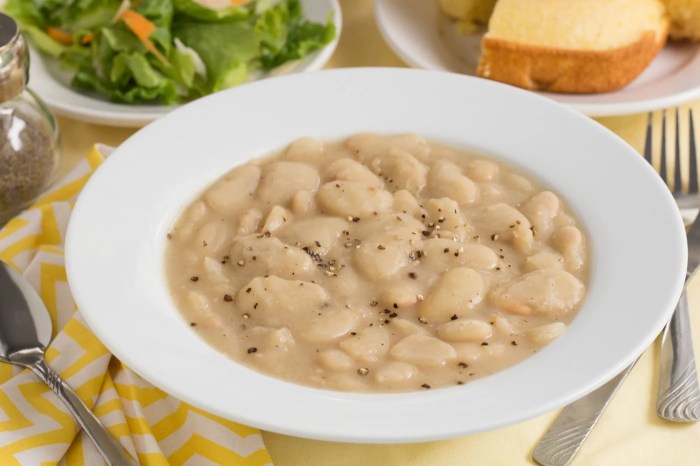
Butter beans, with their creamy texture and mild flavor, have found their way into kitchens and culinary traditions across the globe. From hearty stews to vibrant salads, these versatile legumes are a staple in numerous cuisines, adding a touch of both comfort and sophistication to dishes.
Mediterranean Cuisine, Butter beans recipe
Butter beans, known as “fava beans” in the Mediterranean region, are a key ingredient in many traditional dishes. They are often used in salads, stews, and dips, adding a creamy texture and nutty flavor.
“In Greece, butter beans are used in a popular salad called “fava,” which features fava beans, onions, and olive oil. This simple yet flavorful salad is often served as a meze, or appetizer.”
“In Italy, butter beans are used in a variety of dishes, including pasta sauces, soups, and stews. A classic Italian dish featuring butter beans is “pasta e fagioli,” a hearty soup made with pasta, beans, and vegetables.”
Latin American Cuisine
In Latin America, butter beans are a popular ingredient in a variety of dishes, including stews, salads, and rice dishes. Their creamy texture and mild flavor complement the bold spices and flavors often found in Latin American cuisine.
For descriptions on additional topics like infinite craft recipes, please visit the available infinite craft recipes.
“In Mexico, butter beans are a key ingredient in “frijoles de la olla,” a traditional bean soup made with pork, vegetables, and spices. This hearty soup is a staple in Mexican cuisine and is often served with tortillas.”
“In Brazil, butter beans are used in a variety of dishes, including “feijoada,” a national dish made with black beans, pork, and other ingredients. Butter beans add a creamy texture and mild flavor to this hearty stew.”
Asian Cuisine
While not as prevalent as in other regions, butter beans are making their way into Asian cuisine, particularly in vegetarian and vegan dishes. Their creamy texture and mild flavor complement the bold flavors of Asian cuisine.
“In Thailand, butter beans are sometimes used in curries, adding a creamy texture and nutty flavor. They are often combined with coconut milk, spices, and vegetables.”
“In India, butter beans are used in a variety of vegetarian dishes, including stews, curries, and salads. They are often combined with spices, herbs, and vegetables, creating flavorful and satisfying meals.”
Butter Bean Storage and Preservation: Butter Beans Recipe
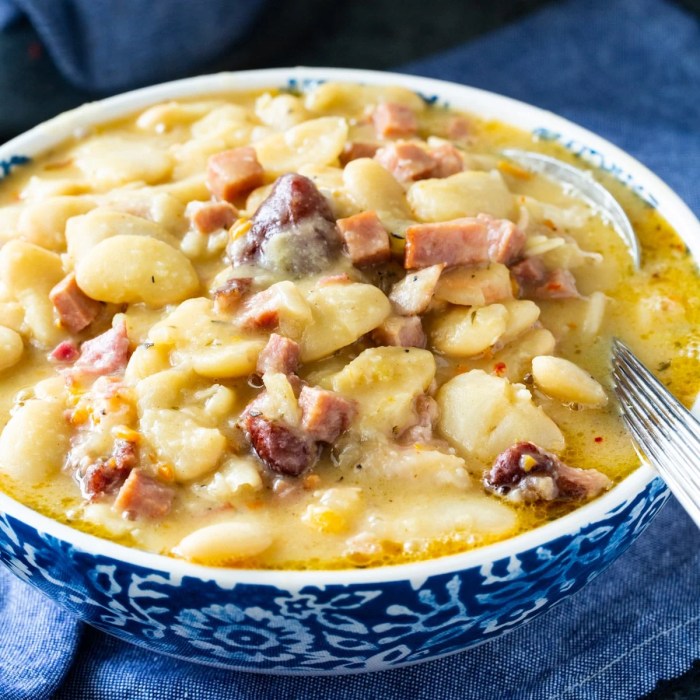
Butter beans, whether fresh or dried, require proper storage to maintain their quality and flavor. Understanding the best storage methods and preservation techniques can help you enjoy these legumes for longer.
Storing Fresh Butter Beans
Fresh butter beans are typically available in pods. To store them, it’s essential to keep them cool and moist.
- Refrigerate:Fresh butter beans should be stored in the refrigerator’s crisper drawer. Wrap them loosely in a paper towel or a clean cloth to absorb excess moisture and prevent them from becoming soggy. They can last for about 3-5 days in the refrigerator.
- Freezing:If you plan to store fresh butter beans for longer, freezing is a good option. Blanch the beans for 2-3 minutes in boiling water, then plunge them into ice water to stop the cooking process. Drain well and package them in freezer-safe bags or containers.
Frozen butter beans can last for up to 6 months.
Storing Dried Butter Beans
Dried butter beans are more durable and can be stored for extended periods.
- Airtight Container:Store dried butter beans in an airtight container in a cool, dark, and dry place. This will help prevent them from absorbing moisture and becoming moldy.
- Refrigerator:For longer storage, you can store dried butter beans in the refrigerator. This will further slow down the oxidation process and help maintain their freshness.
Preserving Butter Beans
Preserving butter beans allows you to enjoy them throughout the year. Here are some common methods:
- Canning:Canning is a reliable method for preserving butter beans. It involves sealing the beans in jars with a high-pressure canner to kill bacteria and create a vacuum seal. This method can extend the shelf life of butter beans for up to a year.
- Freezing:Freezing is a simple way to preserve butter beans. Blanch the beans for 2-3 minutes in boiling water, then plunge them into ice water to stop the cooking process. Drain well and package them in freezer-safe bags or containers. Frozen butter beans can last for up to 6 months.
- Drying:Drying is another method for preserving butter beans. It involves removing moisture from the beans through sun drying or using a food dehydrator. Dried butter beans can be stored for several months in an airtight container in a cool, dark, and dry place.
Shelf Life and Storage Conditions for Preserved Butter Beans
The shelf life of preserved butter beans depends on the method used.
- Canned Butter Beans:Properly canned butter beans can last for up to 12 months in a cool, dark, and dry place.
- Frozen Butter Beans:Frozen butter beans can last for up to 6 months in a freezer at 0°F (-18°C).
- Dried Butter Beans:Dried butter beans can last for several months in an airtight container in a cool, dark, and dry place.
Final Review
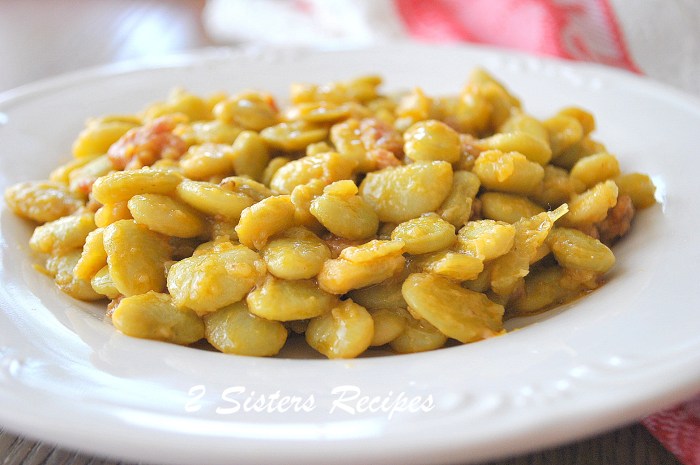
Butter beans, with their rich history and diverse applications, are a culinary treasure waiting to be explored. Whether you’re a seasoned chef or a home cook, this guide provides the tools and inspiration to unlock the potential of these humble legumes.
So, embrace the versatility of butter beans, experiment with different flavors, and enjoy the delightful culinary journey they offer.
